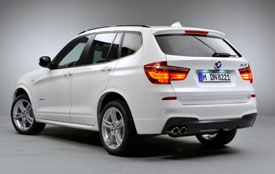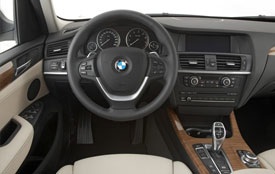2011 BMW X3
BMW as a company strives to stay ahead of the game, and such was the case with the 2004 X3 Sport Activity Vehicle. The X3 was the first compact crossover from a luxury sedan brand. And, despite a somewhat cramped interior and rough ride, its BMW-honed performance made it shine. Well, now a bigger, more comfortable, X3 has arrived. So, is it still just as much fun to drive, or has the new X3 gone soft?
Growing comfort and space were indeed the main design targets for the 2011 BMW X3 Sport Activity Vehicle, but if our first drive is any indication, it certainly hasn’t gone soft. The ride certainly has improved thanks to a redesigned anti-dive strut suspension up front and a five-link arrangement in the rear, but it remains plenty solid. And the optional Dynamic Damper Control allows a driver tuned ride.
A Lexus it’s not, however, as optional 19-inch wheels and Pirelli low profile tires keep things feeling taut not plush. Handling is very responsive, but the X3 does still feel tall and there is some head tossing; at times feeling almost like a traditional body on frame SUV.
 But on the track, traditional BMW was more the feel, as it scooted through our slalom course like a 3-series sport sedan, which is to say fast and well balanced, despite that taller center of gravity. Steering is among the best we’ve felt in an SUV. Handling benefits from the xDrive permanent all-wheel-drive system. In addition to being rear-biased, it works with Dynamic Stability Control to apply braking to the inside rear wheel when cornering to reduce both understeer and sharpen response.
But on the track, traditional BMW was more the feel, as it scooted through our slalom course like a 3-series sport sedan, which is to say fast and well balanced, despite that taller center of gravity. Steering is among the best we’ve felt in an SUV. Handling benefits from the xDrive permanent all-wheel-drive system. In addition to being rear-biased, it works with Dynamic Stability Control to apply braking to the inside rear wheel when cornering to reduce both understeer and sharpen response.
Off the line, our X3 xDrive35i slams you in your seat as it propelled us to 60 in 6-seconds flat. The engine is strong and sounds mean. Power is immediate, as we noticed no turbo-lag. The quarter mile passed in 14.6-seconds at 95 miles per hour feeling smooth and progressive all the way down the track. The throttle is firm, and shifts from the 8-speed automatic are quick and direct.
Power for the X3 lineup comes from a pair of familiar, 3.0-liter inline-6’s. While the base xDrive28i is normally aspirated, our xDrive35i sports twin turbos and BMW’s Valvetronic and Double-VANOS Stepless Variable Valve Timing for 300-horsepower and 300 lb-ft. of torque. Nice round numbers both.
Also nicely rounded out is the X3’s new styling. The design has been cleaned up all around, especially at the rear. It’s still classic BMW up front, however, with a deep front apron and signature twin kidney grilles pointing to more aggressive hood and fender lines. In profile, the look is classier with exaggerated flair for even more personality than before. A liftgate mounted rear spoiler, a pair of polished exhaust tips, rocker trim, and fender-mounted turn signals add to the sporty persona.
Inside the X3, fit & finish are improved as is t he feel of many materials, though a fair amount of black plastic remains, giving it more of an athletic feel, not rich or overly inviting. The interior is very quiet, however, and optional dual sunroofs do add an airy feel. While this may be the entry level BMW crossover, it’s still available with all the expected BMW fitment, including the latest iDrive. We found the seats from the X3’s Sport Activity Package a bit hard with overly aggressive side bolstering for a utility.
he feel of many materials, though a fair amount of black plastic remains, giving it more of an athletic feel, not rich or overly inviting. The interior is very quiet, however, and optional dual sunroofs do add an airy feel. While this may be the entry level BMW crossover, it’s still available with all the expected BMW fitment, including the latest iDrive. We found the seats from the X3’s Sport Activity Package a bit hard with overly aggressive side bolstering for a utility.
Most of our staff were annoyed by the flickable electronic gear shift, and the buttons for Dynamic Damping took some getting used to. But, in typical BMW fashion all controls are driver-oriented. Rear seats are very comfortable, and room is better, but still barely adequate. While cargo capacity, with all seats in use, actually falls a bit to 27.6 cubic-feet. But, the cargo floor does feature sliding rails with adjustable tie-downs for securing loads… all accessed by an optional power lift gate.
Government Fuel Economy ratings for the 2011 BMW X3 xDrive35i are 19 City and 26 Highway, so our average of 20.1 miles-per-gallon of Premium was disappointing. The Energy Impact Score is a moderate 16.3 barrels of oil per year, with a carbon footprint of 8.9 annual tons of CO2.
Built in Spartanburg, South Carolina, the BMW X3 xDrive28i begins at $37,625. Our xDrive35i is based at $41,925, but can easily crest 50G’s with options. So, for a compact crossover, it is definitely pricey.
But then, no one ever claimed an ultimate driving machine would be cheap. And, the 2011 X3 is a true BMW and a fine follow-up to the original. Its big price and sporty character won’t appeal to everyone, but it’s perfect for both the BMW faithful, and those that have always wanted a BMW but needed more utility than a car. It will sell long and well.
Specifications
- Engine: 3.0 liter DOHC
- Horsepower: 300
- Torque: 300 lb-ft
- 0-60 mph: 6 seconds
- 1/4 mile: 14.6 seconds @ 95 mph
- EPA: 19 mpg city/ 26 mpg highway
- Energy Impact: 16.3 barrels oil/yr
- CO2 Emissions: 8.9 tons/yr
2024 Hyundai Elantra
Basic Transportation At Its Best…And That Is A Compliment
For those of you who write in every week bemoaning the fact that all we seem to do around here is test incredibly expensive cars and EVs that only the very well to do can afford, this one’s for you. It’s a commuter and budget friendly mainstay from Hyundai, the compact Elantra sedan. And, it has been nicely updated for 2024.
We clearly do enjoy driving high-performance machines and ultra-luxury rides around here, but like most of you, when it comes time to drive home at the end of a long workday, we do so in something much more practical and affordable, like this 2024 Hyundai Elantra sedan.
If you’re thinking the front end has gotten more aggressive, you’re right. Hyundai calls it a “Shark Nose” theme, and we’re guessing they were thinking more Great White than Hammerhead, though Megamouth shark would also apply. It helps for a low and wide look; more substantial than the typical compact. Other additions for ’24 include slimmer daytime running lights, revised stainless steel Hyundai emblem, reshaped front fenders, sport sedan-style rear diffuser with silver trim; a parametric pattern added to the C-Pillar, and new LED taillights that take up a lot more space on the highly sculpted decklid. Plus, new wheel designs in sizes ranging from 15- to 18-inches.
Standard engine in SE, SEL, and Limited grades is this naturally aspirated 2.0-liter I4 with 147 horsepower and 132 lb-ft of torque. Even with no hybrid assistance, it gets substantial Government Fuel Economy Ratings of 31 City, 40 Highway, and 34 Combined; we averaged a great 38.6 mpg of Regular.
Those high fuel economy numbers mean acceleration times are pretty high as well. It was in no particular hurry to get off the line at our test track, as after a slight jolt of power, it felt pretty sluggish going down the track, taking us a lengthy 9.4 seconds to hit 60 mph. Hyundai’s Intelligent Variable Transmission has some realistic simulated gear shifts built in, and they not only provided the feel of a true automatic, but kept engine noise from becoming overbearing. And while this 2.0-liter may not be a house-on-fire off the line, it has no problem keeping up with traffic, and feels like just the perfect amount of power for a practical and safe commuter car.
There are other engine options too. Two choices if you want to go faster, a 1.6-liter turbo with 201 horsepower in the Elantra N Line, and a 276-horsepower turbocharged 2.0-liter for the Elantra N; plus, one with even better fuel economy, a 1.6-liter hybrid with a 139 horsepower total output.
And despite some significant understeer, there was good feel through the cones of our handling course, both in steering and chassis feedback. We wouldn’t quite call it “point and shoot,” but it responded to inputs fairly quickly, with only moderate body roll. All-in-all, when it comes to performance, it doesn’t claim to bring a whole lot to the table, but does clearly overachieve with what it does bring.
And Hyundai is always overachieving when it comes to packing in features, yet has found a way of keeping things refreshingly simple with a good mix of touchscreen and manual controls. Lots of space too, both up front in the surprisingly wide front buckets, and in the rear bench with ample room for three. Updates for all Elantra interiors include softer materials on the door panels, upgraded instrumentation and additional charging ports, plus a surround view monitor and new H-Tex simulated leather for Limited trim.
Elantra pricing starts with an SE at $22,775, the SEL comes in at $24,725, Limited begins at $28,215, and the sporty N Line starts at $29,615. If you’re interested in the hybrid, base Blue starts at $27,400 with Limited at $30,600.
Some might say there’s not a whole lot that’s earth shaking about the 2024 Hyundai Elantra, but that’s mostly why we like it so much. When it comes to just delivering good, basic transportation with a high dose of unexpected amenities, Hyundai delivers once again.
Specifications
- Engine: 2.0-liter I4
- Horsepower: 147
- 0-60 mph: 9.4 seconds
- 60-0 Braking: 111 ft (avg)
- MW Fuel Economy: 38.6 MPG (Regular)
- Transmission: IVT
- Torque: 132 lb-ft
- 1/4 Mile: N/A (Track Maintenance)
- EPA: 31 City / 40 Highway / 34 Combined







